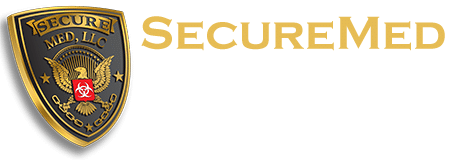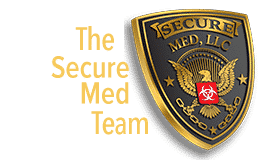How To: A Guide to Hazardous Medical Waste Disposal
If you’re dealing with hazardous medical waste, you already know that disposing of it should not be taken lightly. Between local, state and federal guidelines and laws, HIPAA and OSHA mandates, and PHI (personal health information) protection, there is a lot to pay attention to. And when you think about the big picture, properly disposing of any kind of hazardous medical waste prevents the spreading of disease and infections, and it helps to keep the environment clean. But if you’re new to the medical industry, or you’re looking for a specific list of steps, then this is for you.
A Brief History: Medical Waste
Medical waste management regulations were put into place in the 80’s, mainly spearheaded by the World Health Organization (WHO). Currently in the United States, hazardous waste management is regulated by the Environmental Protection Agency (EPA) and the Occupational Safety and Health Administration (OSHA). Additionally, the Center for Disease Control (CDC) also provides guidelines for the management of biohazard waste. Finally, each state, university, center, company, facility, or organization has its own standards and practices. Since approximately 5.9 million tons of medical waste is produced by hospitals in the US each year, these regulations are more than necessary and should be followed explicitly.
Now that you know how it came to be and which organizations and regulations you need to know, here are the steps to properly disposing of hazardous medical waste:
Step 1: Identify
The most important step for any kind of waste disposal is identifying what you’re dealing with. There are two main kinds of medical waste: Regulated medical waste and Unregulated medical waste. If you’re dealing with any kind of hazardous material (i.e. if it’s something that could kill or hurt someone or make them sick), then you’re dealing with the Regulated medical waste (RMW). While the majority of waste is considered UMW, anything considered RMW should be handled carefully – if you’re unsure, it’s better to be safe than sorry. Whether or not something is hazardous changes the way you need to dispose of it, so it is imperative to accurately identify anything hazardous. Each item you receive for medical services should come with a Safety Data Sheet (SDS) to tell you how it should be disposed of, or you can hire a medical waste disposal company to take a sample and run analytics.
Step 2: Packaging
When dealing with any kind of waste, it’s important to have the proper containers to hold that waste. All waste should be divided by non-hazardous and hazardous items, and you should have specific, well-labeled containers for each type. For any kind of hazardous waste, having the proper container is not only needed, it’s mandated by law. Whether it’s a five-gallon pail or a fifty-gallon drum, having a DOT-approved (Department of Transportation) container is required. You can always contact the DOT if you have questions about what is required. Each type of container should be the appropriate color and should be well-labeled – if you purchase the containers from a reputable medical waste company, all of this should be done for you.
Step 3: Approval
Before you attempt to send waste anywhere, you need to fill out a hazardous waste profile sheet. This sheet is then sent to the waste facility for approval before they can accept any kind of shipment. Because you’re dealing with hazardous waste, the accepting facility will more than likely ask for more detailed information or more testing to be done on the material before accepting and approving a shipment. This is for the safety of everyone involved and so they are fully compliant with all of the laws and regulations for their facility. If you’re prepared for this kind of clarification or follow-up, it will make the process run more smoothly.
Step 4: Paperwork
Not many people enjoy doing paperwork, but this should be an automatic step (and common sense!) for your facility, regardless of how much or what kind of medical waste you’re handling. According to the EPA, the Resource and Conservation Recovery Act (RCRA) is the basic standard for hazardous waste management. If you’re producing any kind of hazardous waste, your facility is considered a hazardous waste generator. To ensure that you have all of the proper paperwork and required information (like a hazardous waste manifest, EPA code, waste labels, etc.), you need to follow the RCRA guidelines. These guidelines are not exhaustive, and you should always check with your state regulatory agency to cover all your bases.
Step 5: Preparation
As the waste generator, you are responsible for every step of the process (‘cradle to grave’ liability), so it’s up to you to make sure that everything is done by the book. Once the waste is ready for shipment, you must ensure that the waste is in a shippable form and that all containers and drums are properly sealed and labeled. If you’re working with a medical waste disposal company, confirm that they’re fully insured, fully compliant and that their vehicles and drivers are all DOT-approved. Because they’re handling hazardous waste, each truck will likely be stopped at a DOT station, and a DOT official will check that everything is being handled properly, so if you’ve done your due diligence, that will save everyone time and money, and the shipment can move to the waste facility more quickly.
Step 6: Treatment
Once the waste arrives at the predetermined facility, it will go through the necessary treatment process. Whether it’s treated via incineration, thermal (autoclave), irradiation (microwave), or chemically, the facility will handle the waste in the appropriate way.
Handling hazardous waste is no joke – take the time to make sure your company is properly disposing of any and all of it! If you’re looking for a medical waste disposal company to handle your hazardous medical waste, contact us at SecureMed – we can answer your questions and give you a fair, quick quote. Our team is ready to review your needs and come up with a solution to fit your budget!







